In today’s world, travel is more diverse than ever. Whether you’re seeking relaxation, adventure, independence, or purpose, there’s a travel style for every type of traveler. Below is a breakdown of the most common forms of travel and what you can expect from each.

1. Package Tour / Group Tour
Features: Everything is organized by a travel agency—transportation, accommodation, meals, sightseeing—and usually includes a tour guide.
Pros:
- Hassle-free and convenient
- Cost-effective when traveling with a large group
Cons:
- Less flexibility
- Must follow a set itinerary, which might not match personal interests
2. Free Independent Traveler (FIT) / Self-Guided Tour
Features: You plan everything yourself—flights, hotels, transport, and activities.
Pros:
- Total freedom and flexibility
- Highly personalized experiences
- Opportunity to explore off-the-beaten-path locations
Cons:
- Time-consuming research
- Must handle any unexpected problems on your own
3. Solo Travel
Features: Traveling alone, without companions.
Pros:
- Absolute freedom
- Encourages self-growth and independence
- Easier to meet new people
Cons:
- Can be more expensive (no cost-sharing for rooms)
- Occasional loneliness
- Requires extra attention to safety
4. Group Travel with Friends or Family
Features: Traveling with people you know—friends, family, or small private groups. Can be self-planned or organized by a private tour company.
Pros:
- Shared experiences and memories
- Cost-sharing
- Built-in companionship
Cons:
- Requires compromises in planning
- Possible disagreements or clashes
5. Backpacking / Budget Travel
Features: Traveling independently on a tight budget, using public transport and staying in hostels or budget accommodations. Prioritizes cultural experiences and exploration.
Pros:
- Budget-friendly
- Deep immersion in local culture
- A real test of resourcefulness and adaptability
Cons:
- Limited comfort and convenience
- Requires good physical health
- Riskier without travel experience
6. RV / Caravan / Motorhome Travel
Features: Traveling in a fully equipped vehicle with living space (bed, kitchen, bathroom).
Pros:
- Full mobility and freedom
- No need for hotels
- Great for exploring remote areas
Cons:
- High rental or purchase costs
- Requires long-distance driving skills
7. Staycation (Local Vacation)
Features: Staying in your own city or nearby areas, usually at a hotel or resort, to relax without long travel.
Pros:
- No travel stress
- Budget-friendly
- Ideal for short breaks
Cons: No sense of new discovery or adventure
8. Workation / Digital Nomad Travel
Features: Combining travel with remote work, ideal for freelancers or remote employees.
Pros:
- Explore while still earning
- Extended stays in new places
- Flexibility in location
Cons:
- Needs reliable internet and workspace
- Requires discipline to balance work and leisure
9. Voluntourism (Volunteer Travel)
Features: Combining travel with volunteer work for community or environmental projects.
Pros:
- Meaningful and fulfilling experiences
- Positive impact on communities
- Deeper cultural understanding
Cons:
- Possible out-of-pocket costs for volunteering
- May involve basic living conditions
Each travel style offers a unique way to experience the world. Whether you crave adventure, connection, comfort, or contribution, choosing the right style for your personality and goals will turn any trip into a memorable journey.
In addition to the commonly known travel types, there are many emerging categories and trends that cater to different needs, perspectives, and purposes. Here’s a deeper look into some other ways travel can be classified:
By Target Audience or Traveler Demographics
- Luxury Travel: Focused on premium experiences—5-star resorts, private yachts, first-class flights, and exclusive services designed for ultimate comfort and indulgence.
- Senior Travel: Tours and packages tailored for older travelers, emphasizing safety, comfort, medical support, and a relaxed pace.
- Family Travel with Young Children: Destinations and services that are child-friendly, featuring amenities such as kids’ clubs, children’s pools, and babysitting services.
- Honeymoon Travel: Romantic, private getaways designed for newlyweds, often with special couple-centric services and secluded locations.
- LGBT Travel: LGBTQ+-friendly tours and destinations where travelers can feel safe, accepted, and comfortable being themselves.
By Primary Mode of Transportation
- Road Trips: Traveling by personal or rental car, often through scenic routes and multiple destinations. Great for flexibility and exploration.
- Rail Travel: Exploring destinations via train—ranging from budget train journeys to luxurious scenic rail experiences.
- Cruise or River Travel: Traveling by cruise ship or riverboat, visiting multiple ports or cities while enjoying onboard amenities and entertainment.
- Air Travel: Primarily using airplanes, ideal for long-distance or international trips across continents.
- Bicycle Tourism (Cycle Touring): Exploring regions on two wheels—ideal for adventure seekers, fitness enthusiasts, and those wanting a slow, immersive travel experience.
By Trend or Modern Travel Philosophy
- Sustainable / Responsible Tourism: Focused on minimizing environmental impact and supporting local communities. Travelers choose eco-friendly accommodations, reduce waste, and engage in meaningful cultural exchanges.
- Slow Travel: An intentional form of travel that favors depth over speed—spending more time in fewer destinations to deeply connect with local life and culture.
- Luggage-Free Travel: Some travelers opt to ship their luggage ahead or travel with only essentials to enjoy the freedom of moving light and stress-free.
- Virtual Tourism: While not a physical form of travel, virtual tourism allows people to explore destinations through virtual reality technology—especially popular during travel restrictions or for those with mobility issues.
As you can see, travel today is incredibly diverse and constantly evolving. The way we categorize it depends on what you want to focus on—purpose, transportation, traveler type, or experience style. And many of these styles can overlap. For example, an independent trip could also be eco-conscious, or a honeymoon might take the form of a luxury rail journey.
Whether you’re chasing adventure, comfort, purpose, or simply the joy of discovery, there’s a travel style for you. The key is finding the one that matches your personality, travel goals, and current life stage.






